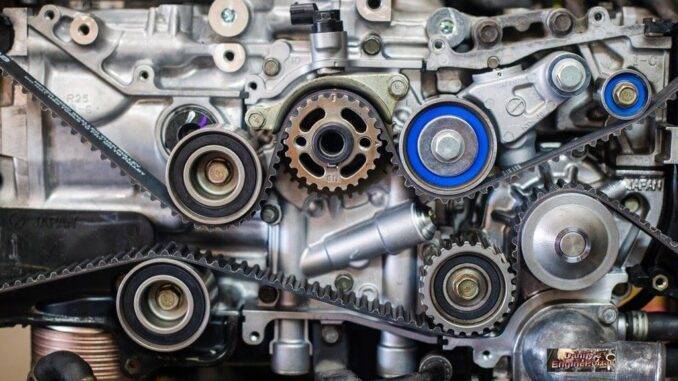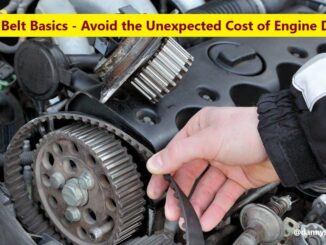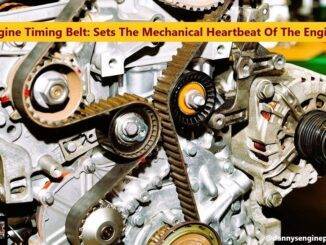
Timing belt failure, can cause catastrophic engine damage.
But, timing belt failure can be avoided, by keeping the timing belt in good operating condition.
So, timing belt failure, has always been a topic, no one wants to talk about. But, as the word spreads, most drivers are more aware of the consequences of timing belt failure.
A timing belt failure, is going to affect more than just the timing belt.
In some engines a timing belt, can also drive additional components. And, may include the water pump, balance shaft, intermediate shaft, injection pump and an oil pump. So, a balance shaft, intermediate shaft and an injection pump, must also be in sequence with the crankshaft.
So, replacing your timing belt, does sound a little daunting. But, it definitely is a proactive way, of saving yourself time and money down the road. But, before we dive into this blog post, there is good news down the road.
Today, many manufactures are actually moving away from timing belts. Because of new technology, the return to timing chains, is growing every day.
So, What Can Happen If You Have, A Timing Belt Failure
When talking about timing belts, it’s also important to know about interference and non-interference engines.
So, an interference engine, is one where the pistons and valves share space in the cylinder. But, not at the same time. The benefit of this type of engine, is efficiency. However, if the belt or chain breaks in an interference engine. the valves and pistons will collide.
As a result, the pistons generally hit the valves, which will bend or snap them. Furthermore, the valves can punch a hole in the top of the pistons. Consequently, the repair bill could easily run, into the thousands.
However, if the belt breaks, in a non-interference engine they won’t collide. Because, they do not ever share the same space.
So, it can be hard to do a visual inspection. But, there are other signs to be aware of, indicating that your timing belt, may be about to fail.
Common timing belt failure and warning signs:
- Ticking noise coming from the engine
- Engine won’t turn over
- Engine misfires
- Oil leaking from in front of the engine
In some engines, a timing belt can also drive additional components, such as:
- Water pump
- Balance shaft
- Intermediate shaft
- Injection pump
- Oil pump
The balance shaft, intermediate shaft and the injection pump, must also be synchronized with the crankshaft.
Furthermore, to work properly a timing belt needs to be, under a certain amount of tension. Some older cars have an adjustable timing belt tensioner, that must be re-adjusted if the timing belt gets loose.
Most, newer cars have an automatic timing belt tensioner, that doesn’t need any adjustment. But, if the timing belt gets loose, it may skip a tooth and the proper timing will be lost.
Do A Visual Inspection
Accessing the timing belt usually involves, removing several of the external accessories.
Here are some visual clues, that your timing belt is in trouble:
- Teeth worn down
- Some teeth sheared off
- Teeth hollowed out
- Edges of belt worn
- The Back of the timing belt cracked
- Belt soaked with oil
- Timing Belt broken
Like any drive belt in any Industry, belts do wear when used regularly. A timing belt will rarely just, snap or break in half. It will normally stretch over time with use. And, that leads us to the number one reason for a, Timing Belt failure, “Incorrect Tension“.
This “Incorrect Tension” can lead to other problems. And, some include, excessive tooth wear, tooth shear and belt noise, just to name a few. Therefore, the correct timing belt tension, is just as important when installing a new belt.
Other causes of timing belt failure:
- Foreign body in Drive
- Belt crimped, due to poor handling
- Seizure of driven component
- Worn Pulleys
- High and Low Temperature
- Oil Leaks
- Belt Misalignment
As listed above, pulley and tension issues, are some of the main causes for Timing Belt Failure. So, why not replace these parts, at the same time as the belt.
Consequently, timing belt kits are the perfect solution, as they have all these accessory parts included.
Such as, Idler Pulleys, Tensioners, Belts, Seals and other items. So, you can replace the complete timing drive. And, not have to worry about, having issues prematurely.
Conclusion
So, the timing belt is responsible for, keeping your engine’s camshaft and crankshaft in sync. As a result, it is subject to incredible exertion. And, typically needs to be replaced within 60,000 – 100,000 miles, depending on the manufacturer’s recommendation.
So, check your owner’s manual for the exact mileage recommendations on your specific vehicle. Consequently, there are only a few warning indicators, that can help you diagnose, a weak or loose timing belt. Finally, there are no obvious clues to indicate, you are close to a timing belt failure.
BY DANNY BENDER




